#Callophrys
Explore tagged Tumblr posts
Text

Sandia Hairstreak (Callophrys mcfarlandi), family Lycaenidae, Big Bend National Park, TX, USA
Photograph by Cecil Wingfield
#hairstreak#lycaenidae#callophrys#butterfly#lepidoptera#insect#entomology#north america#animals#nature
717 notes
·
View notes
Text

Green hairstreak butterfly (Callophrys rubi)
Photo by Robert Thompson
#Callophrys rubi#Callophrys#green hairstreak#butterfly#hairstreak#green#green butterfly#colorful butterflies#insects#colorful insects#lepidoptera#lycaenidae#insect photography#nature
16 notes
·
View notes
Text

Rhaphiolepis shrubs and Callophrys ferrea
43 notes
·
View notes
Text
Butterfly #42: Western Pine Elfin (Callophrys eryphon)



Image credits: 1, 2, 3
Found in British Columbia east to Maine and south California, Arizona and New Mexico, this butterfly's larvae hibernate during winter.
23 notes
·
View notes
Text

19 notes
·
View notes
Text


Green hairstreak (Callophrys rubi)
#Callophrys rubi#green hairstreak#butterfly#beautiful butterfly#insect photography#insects#polish animal#animal photography#animal#animal lover#wild animals#wildlife photography#wildlife#wildlife pictures#spring#sunny day#beautiful#beautiful photos#my photo#photography#photooftheday#naturecore#photoart#forest#woods#forest view
13 notes
·
View notes
Text

Mario Wong
Golden-browed Chlorophonia
The golden-browed chlorophonia (Chlorophonia callophrys) is a species of bird in the family Fringillidae. It is found in Costa Rica and Panama. It is uncommon in subtropical or tropical moist montane forest above 750 m (2,460 ft) elevation.
318 notes
·
View notes
Text






I´ve been drawing more fairies - who would've thought
For context : Rosci's (summer fairy dude) little sister Mango - Merolina and Citha as children - The autumn brothers as children - Viro's lil kissing booth Mango who fails at cathing a ripe man, Professor Callophrys
236 notes
·
View notes
Text
Clanmew Expansion Pack: Moths and Butterflies
A guide to the beautiful fluttering insects seen in this region, and how Clan cats classify and describe them.
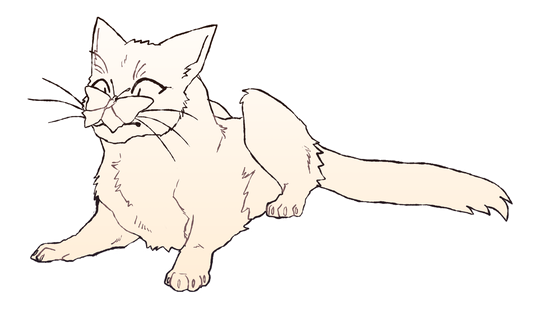
[ID: A cat with a butterfly on its nose]
In Clanmew, the vocabulary used to describe butterflies is massive compared to English. As a species less than a foot tall and spending their entire lives in the wilderness, Clan cats observe lepidopterians up close and far more personally than humans have done historically.
Combine this with the fact that cats are crepuscular, active in the morning and evening, and you'll realize that they encounter more moths than butterflies. While English-speaking humans tend to think of moths as being dingy and butterflies as being colorful, Clan cats don't find those categories helpful and classify them in a completely different way!
So the very first thing to know is that Clanmew does not have the same conception of "moths" and "butterflies." They have a super term, "Ffyy," and no less than 9 terms for the various groups with related behaviors.
This guide contains 51 new words for various moths and the unique behaviors of lepidopterians. Below the cut, you will find;
An overview to the 9 classifications Clan cats use, plus words for things like cocoons, metamorphosis, caterpillars, etc
A straightforward list of species, in English (Science) = Clanmew format
Expansion on behaviors of noteworthy species within their groupings
Translation trivia on Moth Flight, Mothwing, Archeye, and Mothwhisker (TC) for Better Bones.
(Translator's Note: I have tried to pick English words that will work nicely as warrior name prefixes, to be translated as specifically or as generically as you desire. They don't reflect cladistic accuracy.)

Types of Ffyy:
Flutter = Kffa Ffyy with large hindwings that flutter around erratically. The closest to the English image of a "butterfly." Most of these are daytime species but this also refers to moths that are drawn to flame. Species depicted: Speckled wood (Pararge aegeria)
Hawkmoth = Uff Fat-bodied ffyy that tend to be wider than they are long, with powerful wings. Fantastic fliers and important pollinators, they have several gigantic species and are beloved by Clan cats. Species depicted: Elephant hawkmoth (Deilephila elpenor)
Tortrix = Owyy Round-winged ffyy that rest with a slightly splayed pose with their wings folded down, almost resembling a turtle. Species depicted: Privet tortrix (Clepsis consimilana)
Veneer = Iff A thin, lanky ffyy that rests in a sticklike pose with a defined head, sporting big, buggy eyes and sometimes a large nose. Any moth with the characteristic eyes or nose gets brought back into this category. Species depicted: Garden-grass veneer (Chrysoteuchia culmella)
Herald = Hawof A very unique type, it can apply to just about any type of moth but is always given to the species with significance in prophetic divination. There are some moths rarely seen in this region which appear only as heralds, thus they are named accordingly. NOTE: This is the sort of word bestowed in Honor Titles. Species depicted: Common Hairstreak, Moth Flight's moth (Callophrys rubi)
Dowd = Gyyff Stiff, fluffy moths which rest as straight as a twig, usually mimicking wood. Their heads aren't as well defined as a veneer, but they aren't as fluffy as a raoff Species depicted: Buff-tip (Phalera bucephala)
Prominent = Raoff "Lion moths," large species with fluffy antennae and big manes. Something between a dowd and a tortrix, but usually larger and fluffier. Species depicted: Muslin moth (Diaphora mendica)
Plume = Ffip Very thin, slender moths that rest in a T-pose with very interesting wing-types. Species depicted: Beautiful plume moth (Amblyptilia acanthadactyla)
Fritilary = Ffow Somewhat between a Kffa and an Owyy, refers to Ffyy with a smoother 'cape' shape when they're resting.
In addition, there are words for shapes associated with Ffyy and other insects, especially in the wings and patterns. Some of those words are;
Fluttered/Fluttering/Will flutter = Afafaf/Afafa/Afaf The erratic wingbeats of Ffyy and small birds of prey.
Hovered/hovering/will hover = Hyyffuhu/hyyffu/hyyff A very special aerial maneuver where an animal can hold their exact place in the air and move in any direction. EXTREMELY rare; only achieved by certain hawkmoths, hoverflies, and dragonflies. NOTE: The UK has no hummingbirds! Their ecological niche is occupied by hawkmoths!
Shy = Wro An emotion, but also a pose. It's when an animal shrinks back and tries to make itself smaller or more hidden, much like a Dowd or a Veneer, or the flattening of a terrified cat's ears
Cape/Humble = Froom An emotion, a shape, and a pattern that is seen on the backs of some animals, describes the way that Prominents and Tortrixes hold their wings.
Flare/Confident/Perpendicular = Akeye An emotion and a shape, describes things that 'stick up,' like the wings of Plumes and Butters. Not like "raised hackles," more like fluffing one's fur out or puffing your chest.
Caterpillar = Poog A word that comes from Parkmew! Caterpillars were significant to Park cat culture because of their old naming system-- cats were born unnamed, and were expected to find one as they grew, like butterflies.
Pupa/Chrysalis = Higab Hard, scaly insect cocoons
Cocoon = Mooun Soft, silky insect cocoons
Silk = Mirro The material that silk cocoons and spider webs are made of. Only cob spiders produce though of this material to be useful to Clan cats; they do not have access to silk moths (bombyx mori) in this part of England. Clan cats also believe that moth wings are made of this.
Chitin = Higko The material that hard pupa and insect exoskeletons are made of.
Exoskeleton = Babaak The hard shell that surrounds the meat of invertebrates such as crabs, moths, beetles; Clan cats do not think this applies to insects that 'shrivel' such as soft-bodied caterpillars.
Metamorphosed/metamorphing/will metamorph = Peb'bep'arr/Peb'bep/Peb'be To massively change between stages of life, the unique way that moths and some other insects grow.
LIST OF SPECIES
This list is arranged with several species of each group, separated by grouping. You can expect for this list to grow, if additional species are translated as time goes on!
Last update: 6/17/2023
HAWMOTH/UFF
Elephant hawkmoth (Deilephila elpenor) = Beksu
Large skipper (Ochlodes sylvanus) = Skepb
Hummingbird hawkmoth (Macroglossum stellatarum) = Lipfu
TORTRIX/OWYY
Privet tortrix (Clepsis consimilana) = Frooke
Oak lantern (Carcina quercana) = Byoff
Common footman (Eilema lurideola) = Yyowo
Dark Arches (Apamea monoglypha) = Oyiw
VENEER/IFF
Garden-grass veneer (Chrysoteuchia culmella) = Chuo
Drinker moth (Euthrix potatoria) = Ssbwohl
Bronze alder moth (Argyresthia goedartella) = Holipo
DOWD/GYYFF
Buff-tip (Argyresthia goedartella) = Kooko
Apple leafminer (Lyonetia clerkella) = Rugna
Hazel slender (Parornix devoniella) = Geehees
PROMINENT/RAOFF
Muslin (Diaphora mendica) = Goorf
Iron prominent (Notodonta dromedarius) = Orge
True lover's knot (Lycophotia porphyrea) = Urmrri
Cinnabar (Tyria jacobaeae) = Genra
PLUME/FFIP
Beautiful plume (Amblyptilia acanthadactyla) = Lebl
Twenty plume (Alucita hexadactyla) = Arrffip
FLUTTER/KFFA
Speckled wood (Pararge aegeria) = Yaero
Holly blue (Celastrina argiolus) = Luya
Clouded border (Lomaspilis marginata) = Oogwo
FRITILARY/FFOW
Magpie moth (Abraxas grossulariata) = Peewo
Mint moth (Pyrausta aurata) = Mwifg
Riband wave (Idaea aversata) = Fisip
HERALD/HAWOF
Green Hairstreak (Callophrys rubi) = Ssefyy
Lunar Hornet (Sesia bembeciformis) = Offes
Death's Head (Acherontia atropos) = Wayoff
HAWKMOTH/UFF

[ID: An "Uff," 'Hawkmoth' in English. It is a large, yellow-and-pink moth. The species depicted is an Elephant Hawkmoth.]
Hawkmoths are the largest types of Ffyy that Clan cats encounter, and deeply beloved. They are considered the 'warriors' of moth-standards, large, honorable, and acrobatic. What defines an uff from other butterflies is primarily its large, bulky body. Some uff, such as the skipper, could be mistaken by outsiders as being a type of ffow or perhaps a kffa.
They are pollinators, jumping between various flowers and mostly seen in grassy, floral environments, such as meadows and moorland. The skipper in particular is one of WindClan's most common butterflies, and a favorite target for pouncing kittens.
Most of the largest hawkmoths survive the winter snug in their cocoons under leaf litter, and more specifically in ThunderClan. Being able to witness a hawkmoth emerge is sometimes taken as a little blessing, like StarClan rewarding you for staying observant on a patrol.
TORTRIX/OWYY
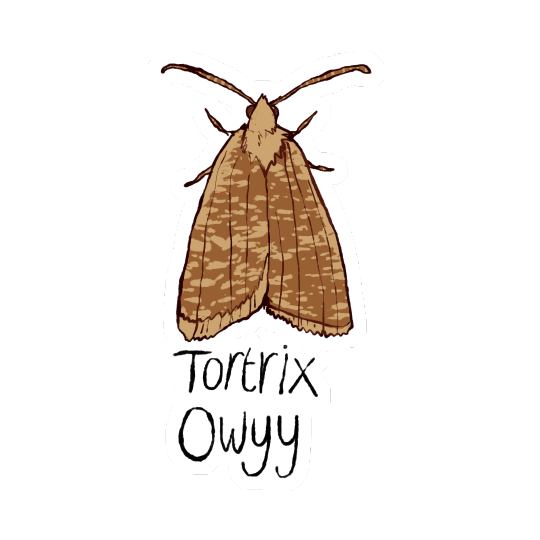
[ID: An Owyy, "Tortrix" in English. It is a humble brown moth with a negligible mane and round, capelike wings. The species depicted is a privet tortrix.]
Tortrixes are the largest classification of ffyy in Clanmew, with many of them being drawn to lights in the dark. They hold their wings 'humbly' (froom), tucked behind themselves and slightly angled. Many prominent share the general shape of tortrixes, but they are separated by a prominent, impressive mane.
Because they are so varied, classifying behaviors of the group as a whole is difficult. Some of them like fruit and others like leaves. Some are large and others small. Some are drab and others colorful.
Most end up named after the species of plant they like most. The Oak Lantern (Byoff) for example can skeletonize entire oak leaves! Others can absolutely mob apple trees, making them a pest to ThunderClan.
Funfact: The cartoon idea of an "apple worm" comes from some species of tortrix moths!
FLUTTER/KFFA
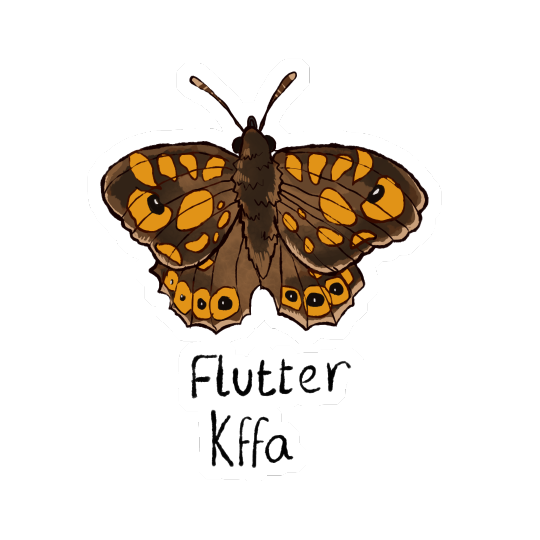
[ID: A Kffa, "Flutter" in English. It is an orange-and-brown butterfly, with wings that stick out perpendicular to the body. The species depicted is a sunspot butterfly.]
Dominated by strange daytime species with bright colors, these confident little creatures are defined by the angle of their wings when resting. They "Flare" out, or Akeye in Clanmew.
The Yaero (sunspot butterfly/speckled wood) is the most well-known of the flutters which isn't also a herald of some sort. These plucky bugs have short lives and spend the ENTIRE time fighting, choosing a sunny spot and engaging in clumsy aerial brawls to defend it. To be compared to a Yaero in Clan Culture is like being called 'scrappy,' fighting until you drop dead of exhaustion.
It's a VERY admirable thing to be!
PROMINENT/RAOFF

[ID: A "Raoff," or a Prominent in English. It is a very fluffy moth with a big mane. The species depicted is a male muslin moth.]
The obvious thing that sets this sort of Ffyy apart from all others is its luscious, majestic mane. Much like how the "Leopard" is a mistranslation and is a mythical composite of several animals, the Clan cat "Lion" is a composite beast whose mane comes from moths!
Thus, it is how they were named. Lion + Moth.
And, of the various raoff, the muslin (Goorf) is one of the most interesting. It comes in black or white, with many cats speaking of a herald coloration that is split perfectly down the middle with black and white. This species' name comes from "Gender + Moth." It is thought that if a pregnant cat only sees black muslins, they will have an all-tom litter. All white, and they will all be mollies. If no muslin moths are seen at all, then they will all reveal themselves to be gib.
FRITILARY/FFOW
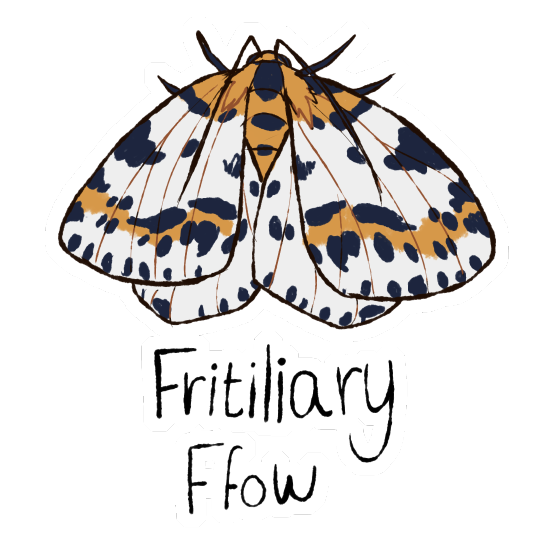
[ID: A "ffow," or a fritilary in English. Note, this is the moment where the English names diverge the most because this is not an irl fritilary. It is a moth with a 'cape' that is both froom, and akeye. The species depicted is a magpie moth.]
A family of ffyy remarked upon for their 'savviness.' Not as 'confident' as kffa, nor as humble as an owyy, the animals in this family are typically quite interesting.
For example, the magpie (Peewo). While notably beautiful like a calico cat, it's also strangely left alone by other animals. If caught in a spiderweb, the spider will take a bite and let go. Birds leave them alone. Clan cats believe this must be because they will eat lots of unappetizing plants and become distasteful-- a clever creature!
The thought probably came from watching another ffow, the Mwifg, the "mint moth" in English. Mint is a deadly poison to Clan cats, but the creature eats it up, and goes unbothered by other animals.
So, Peewo and Mwifg are cited often as living examples of how you, "are what you eat."
PLUME/FFIP
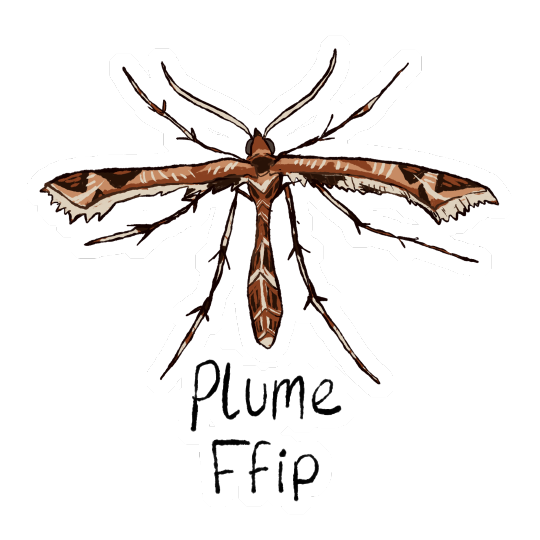
[ID: A plume moth, "ffip," a thin insect with a T-shaped body and long legs. The species depicted is a Beautiful Plume Moth.]
Widely considered the least appealing type of moth, often clustered in reedy areas. They're known by their distinctive T-shape and long legs.
Clan Cats find it unsettling that they resemble midges, and have only two unique names within the classification; Arrffip for the 20-Plume, and Lebl for the Beautiful Plume, which resembles a mottled cat which makes it more okay to them.
VENEER/IFF

[ID: A moth with big eyes and a long nose, called an "Iff" in Clanmew, and a veneer in English. The species depicted is a garden grass veneer.]
The silliest moth of all, associated with being panicked and anxious at all times. To be compared to an Iff is to be called a worry-wart in Clanmew!
Most veneers have a big, distinct fuzzy nose, and any moth that displays the same feature gets thrown into the Iff classification. But that isn't the only way to end up in this category! Any moth with big, worried eyes goes here as well, such as the Bronze Alder Moth (Holipo).
Alderheart was compared to a holipo often. Poor guy.
There is also the drinker moth (Ssbwohl), which is known for dunking its head into dewdrops and taking a big sippy.
DOWD/GYYFF

[ID: A moth that looks like a twig, called a Dowd in English and a Gyyff in Clanmew. The species depicted is a buff-tip.]
To be considered a Gyyff, the moth must be long and sticklike. The apple leafminer (Rugna) is a good example of a moth that is not using buff-tip (Kooko) mimicry, but is still a Dowd in Clanmew standards.
The word "kooko" in Clanmew is used for harmless fibs, little pranks, and the buff-tip moth!
HERALD/HAWOF
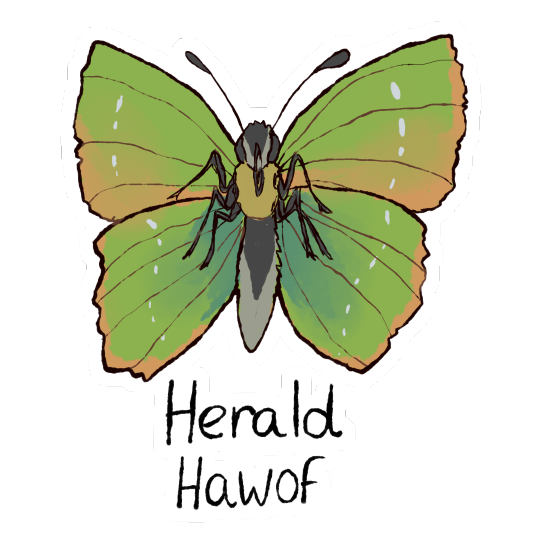
[ID: A green butterfly with shining wings, facing the camera. It is called a Herald in English, and a Hawof in Clanmew. The species depicted is a Green Hairstreak.]
The defining example of the Herald classification is the Green Hairstreak, an iridescent green moth that lead Moth Flight to the Moonstone so many years ago. A vitally important species to WindClan culturally, a burst in its population is said to be a sign that they need to listen carefully.
Any type of moth can end up going into this category, if it becomes significant in divination. Some moths have even shifted over time out of one classification into Hawof, and back out as they stop being seen as holy in some way!
Another example of a moth of great significance is the death's head moth, called a Wayoff in Clanmew. It's a massive type of hawkmoth, and an exceedingly rare sight. It warns of grand doom, threats so large that they threaten all the Clans at once. Floods, famine, deforestation... these were all preceded by the freak sighting of a Wayoff.
Meanwhile, the Lunar Hornet, Offes in Clanmew, mimics a wasp perfectly. It's a strange creature said to be a piece of the cosmic dust between this world and StarClan, an example of the fantastic creatures they can make if they so choose. It signifies change of some sort, which a Cleric will attempt to interpret for the cat who saw the moth.
And lastly,
Translation Trivia

[ID: A cat chasing a butterfly]
Specifically for the way I have chosen to translate the names of these characters for the Better Bones AU
Moth Flight
Mothwing
Archeye
Mothwhisker
Moth Flight Hawof Faofwe (Herald + Pilgrimage)
A VERY interesting translation quirk, as her name is a remnant from Old Tribemew, one of the ancestral languages that would eventually form Clanmew!
Hawof was the ancient word for moths and butterflies, and still the word in-use in Tribemew to this day. Once they moved down from the highlands, Clanmew adopted and created several new words to describe the hundreds of new types they were seeing on a regular basis. Yet, "hawof" fossilized, coming to only describe those that were particularly holy!
"Faofwe" is another fascinating example. While it once meant 'flight' in Old Tribemew, an animal flying from one place to another, it has come to mean "pilgrimage." This is the word being used for a cat going to visit a holy location, or somewhere else that they will reach a higher religious understanding of the world.
Both of these words are sacred; the type only given to modern cats in Honor Titles.
Mothwing Beksuwesk (Elephant Hawkmoth + Insect Wing)
Sasha fled the violence of TigerClan at her first opportunity, after being trapped in the dangerous situation with no escape. After the death of her son, Tadpole, she brought her kits to RiverClan in the hopes they would be safe. Their names were Ffyy, and Yassga.
Leopardstar saw that their father was Tigerstar, and accepted... though she would change their names. They had to accept what the Clan was to decide for them.
So Yassga (Raptor, any large bird of prey) became Yi'i (sparrowhawk), and Ffyy (Any butterfly) was pigeonholed into a type of hawkmoth as Besku. She thinks of this often, that RiverClan took the name her mother gave her, that she followed Hawkfrost to the Lake, and now she is all that remains. With nothing left of her family.
Archeye Oyiwipo (Dark Arches Moth + Eye)
A simple one! He has a stripe just above one eye that perfectly resembles the tip of a Dark Arches' wing.
(note: i updated this translation from an earlier statement.)
Mothwhisker Yaerohussk (Speckled Wood Butterfly + Hussk)
Fresh from the ThunderClan Family Tree fix, Mothwhisker is a parent of Adderfang and Seedfall.
An old Oakstar loyalist, Mothwhisker was spitting from the moment he was born, clawing the nose of his Ba. On the spot, he was given the prefix Yaero, and he eventually grew into a ferocious Crusader after the death of Mapleshade's kittens and the creation of Darkstar's Commandment.
Though "Butterflywhisker" would technically have been accurate, the translator chose 'moth' for brevity. Clan cats don't distinguish between the two, regardless.
#I HOPE YOU ALL UNDERSTAND#THIS IS THE RESULT OF ME SORTING THROUGH HUNDREDS OF INSECTS#AND COMING UP WITH A UNIQUE SYSTEM OF CLASSIFICATION#IM SCREECHING#clanmew#buttterflies#moths#insects#lepidoptera#clan culture#fauna guide#better bones au
168 notes
·
View notes
Text
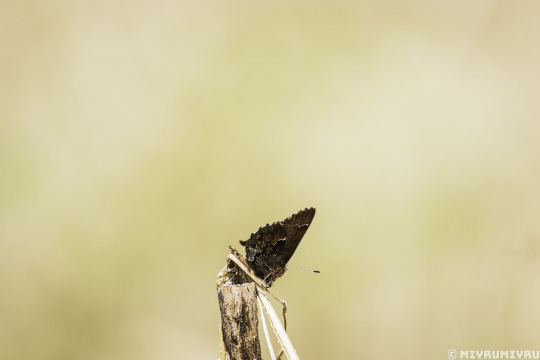
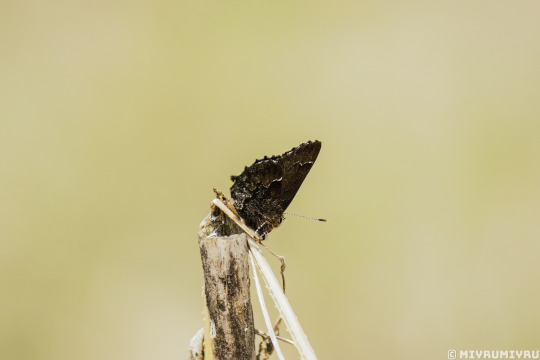

contemplate...
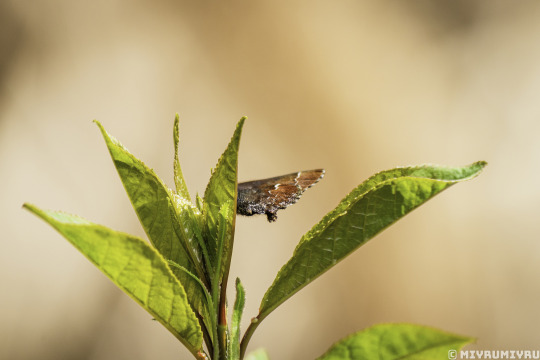

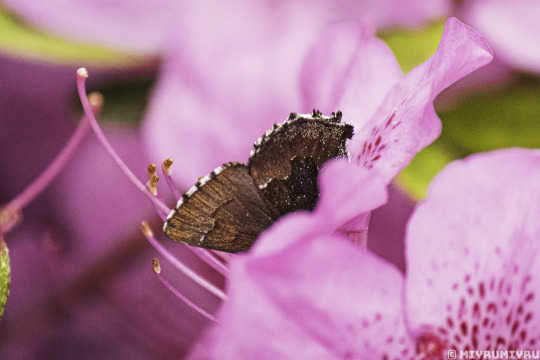
"Thinking too hard, Me need sugar supplement (✿◕⋌◕)"
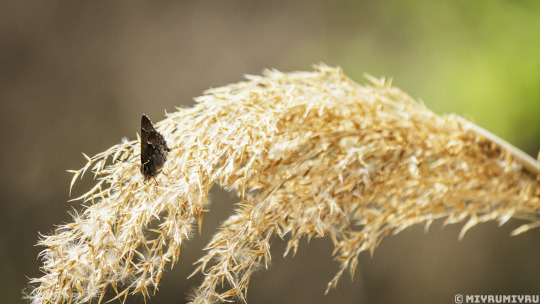

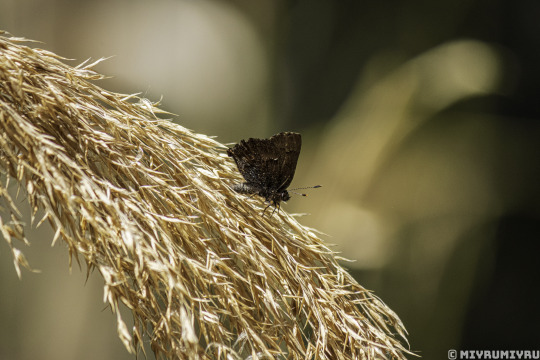
I named an English name for them!
it's "Rusted saw" ^\/\/\/^
북방쇳빛부전나비 (Callophrys frivaldszkyi)
쇳빛부전나비 (Ahlbergia ferrea)
#photographers on tumblr#my photography#original photographers#lensblr#photography#insect photography#wildlife photography#macro photography#nature photography#nature#naturecore#insect#butterfly#butterflies#lycaenidae#bugblr#zoology#entomology#little angel#so tiny#so precious#april 7 2024#april 18 2024#april 22 2024#iron colored gossamer-winged butterflies#unable to take upperside of them because they literally don't unfold their wing ㅜuㅜ#noai#no ai#no to generative ai
25 notes
·
View notes
Text

Juniper or Olive Hairstreak (Callophrys gryneus), family Lycaenidae, West TX, USA
photograph by Diana-Terry Hibbitts
#hairstreak#butterfly#callophrys#lycaenidae#lepidoptera#insect#entomology#animals#nature#north america
712 notes
·
View notes
Text


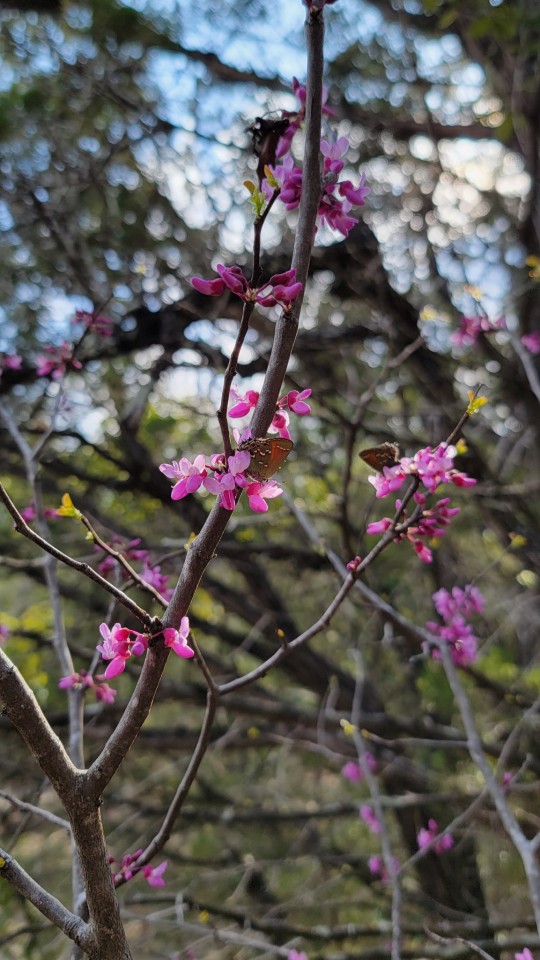
Juniper hairstreak (Callophrys gryneus) on wild onion; mournful thyris (Pseudothyris sepulchralis) and juniper hairstreaks on redbud.
14 notes
·
View notes
Text
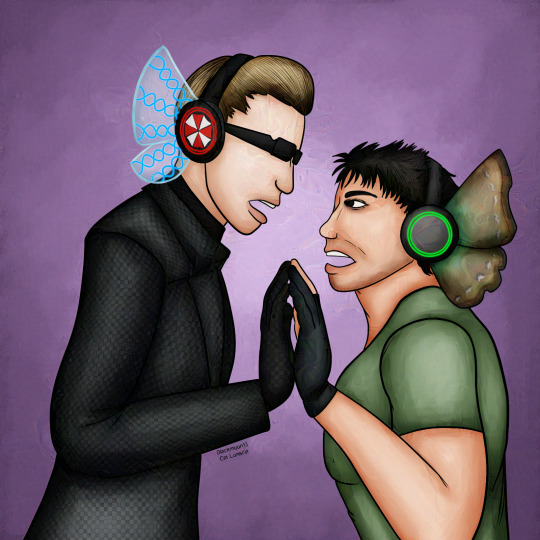
Up to my shinanagins and doing that iconic post with weird odd ships...was also in a resident evil mood and I remember this being a ship...so I made art
Fun fact when drawing this I thought it would be interesting if the butterfly wings were more representative of both of them. Wesker's is plastic, artificial, man mad, Umbrella themed. While Chris's is more natural rustic and is based on a real world butterfly -grabs notes- the Western Green Hairstreak aka Callophrys affinis...I was looking for american butterfly species that could work with well Resident Evil 5 Chris Redfield's outfit. Yea used RE5 a lot for refs, its one of the more icon outfits of Wesker lets be honest...and the pattern was a slight pain to do...thank god for patterns and mesh transform. Tell me what you think and stuff.
#albert wesker#chris redfield#albert wesker x christ redfield#chrisker#resident evil#resident evil 5#speed paint#video game art#resident evil fanart#butterfly wings#volcaloid#ship art
19 notes
·
View notes
Text
Butterfly #29: Green Hairstreak (Callophrys rubi)



Image credits: 1, 2, 3
Found in North Africa, Russia, Anatolia, Siberia, Amurland, Baluchistan, Chitral and most of Europe, this butterfly never rests with its wings down so as to maintain its green camouflage.
18 notes
·
View notes
Text
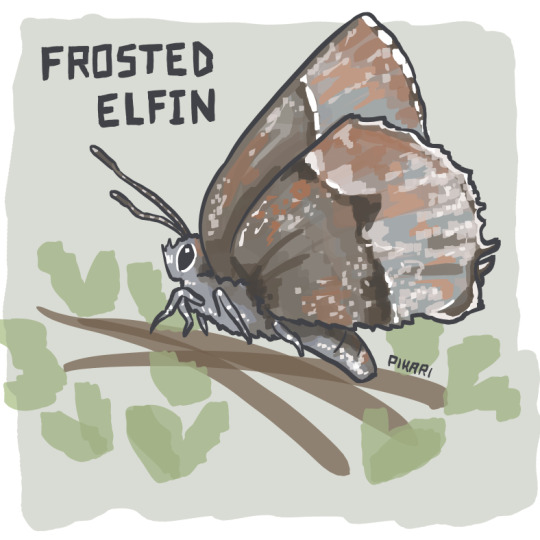
We, the Elfin race, after millennia of observation of our experiment, have decided that humankind... is worthy of stewardship of the planet—once you finally get your shit together.
Frosted Elfin (Callophrys irus)
Eastern USA and Canada
Status: Threatened in some states
Threats: habitat loss
12 notes
·
View notes
Note
re the animals poll, I'd probably send a butterfly, a small humingbird or a cool lil bug like an orchid mantis or something your way. you give me soft, delicate and hardworking vibes :3
I'm– Are you a mind reader Kuroh ?? Those are among my favourite animals !! I have a soft spot for tiny colourful beings !!
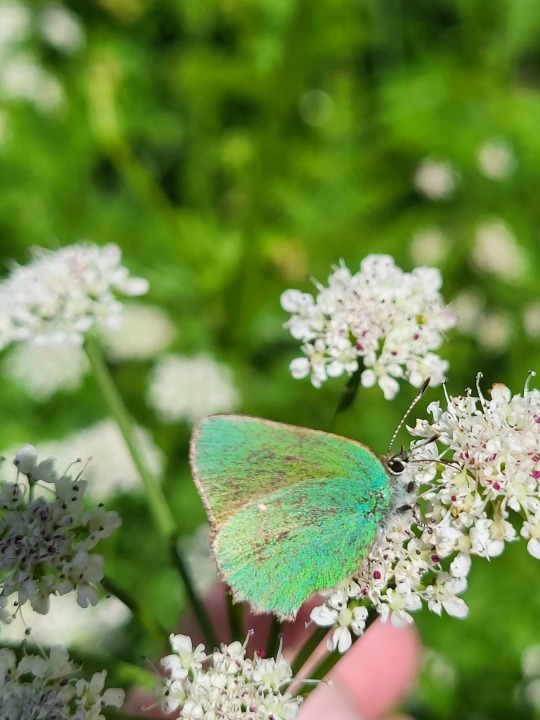

May I interest you in a little Green Hairstreak (callophrys rubi) ?
7 notes
·
View notes